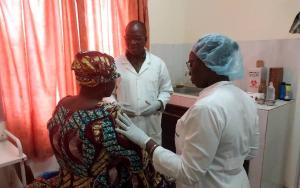Bringing care closer to eliminate cervical cancer
Conakry – For several years many women across Guinea lacked access to screening services for cervical cancer—the most common cancer among women—especially in remote areas. A concerted push by the health authorities to integrate cervical cancer screening in sexual and reproductive health services, thousands of women now have the chance of early detection and adequate support.
Fifteen additional centres were set up in October 2021, bringing to 32 the number of sites now offering cervical cancer screening services in the country. Two facilities are equipped to treat precancerous lesions, a service that is to be expanded expand to all the sites.
“To be honest, if this centre weren’t near my home, I don't think I would have taken the time to go get tested for cervical cancer,” says Nansira Kourouma Traore. The 34-year-old resident of the capital Conakry has benefited from the services of an oncological centre at Donka hospital.
In 2004, the regional and prefectural hospitals of Kankan, as well as all the urban centres of Siguiri, Faranah and Kankan, were equipped for screening and treatment of cervical cancer, with support from the United States Agency for International Development. To serve villages far from those health facilities, a mobile clinic was established to provide testing and referrals to care centres as needed.
The setting up of local screening centres has been coupled with awareness-raising activities. For Traore, it was a radio show that convinced her to go get tested.
“The show made a deep impression on me,” she admits.
Among the 7274 new cancer cases recorded in Guinea in 2021, cervical accounted 26.3% (the majority) of all cancers identified and a mortality rate of 71%. Most cases occur in young women between the ages of 30 and 49, meting out enormous social consequences in the prime of their reproductive life.
The earlier cervical cancer is detected, the higher the chances of recovery.
“Cervical cancer develops silently for at least 15 years if there is no underlying pathology. If in this interval the disease is discovered, precancerous lesions can be treated and the patient easily cured,” explains Professor Keita Namory, head of the Donka Oncology Unit, underscoring that the treatment of precancerous lesions is free in public health facilities.
“When screening is done late, treatment is very expensive and the chances of a cure are slim,” adds the specialist.
A few years ago, stages three and four, the most advanced and severe forms of the disease, accounted for 85 to 90% of cases in the country. But now, thanks to the proliferation of screening centres, the number of terminal cancers has decreased.
“Right now, more than 50% of cases are caught at stage one or two, which improves the chances of recovery,” Professor Namory enthuses.
World Health Organization (WHO) is supporting Guinea's strategy for the elimination of cervical cancer through training of health workers. To date, 495 people have been trained. The Organization is also providing technical, financial, and logistical support during Guinean cancer society science fairs.
“The improvement of care by integrating cervical cancer screening activities into the minimum package of services offered by health centres and hospitals is the best approach to prevent women from being tested too late. We are working on this with the health authorities,” says Dr Casimir Manengu, WHO Representative in Guinea.
WHO has also supported the creation of the Francophone Regional Training Centre for the Prevention of Gynecological Cancers in Conakry, a key institution in the prevention of the main gynaecological cancers, including cervical and breast cancer.
In addition, WHO is providing expertise in the development of the strategic plan for noncommunicable diseases, including gynaecological cancers, the development of a National Cancer Charter, and to the implementation of the National Cancer Control Plan, which makes local screening centres an essential pillar.
Thanks to these centres, Traore has been getting tested regularly for eight years.
“I got into this habit because screening is free,” she says. “If I had to pay, I wouldn’t be able to afford it.”




